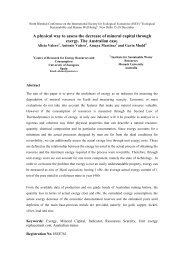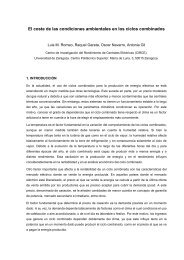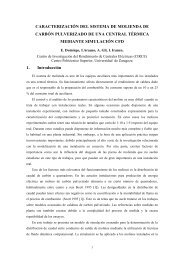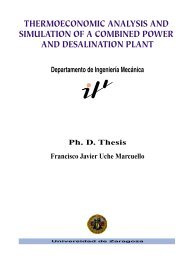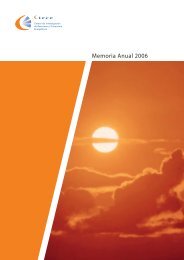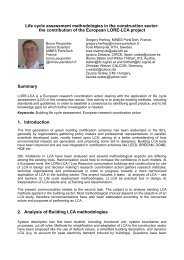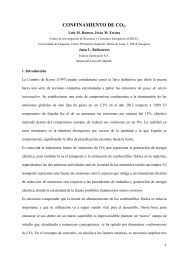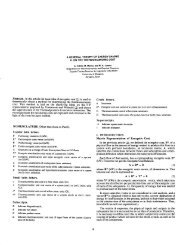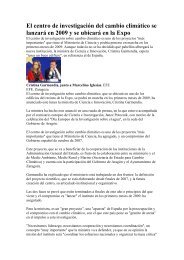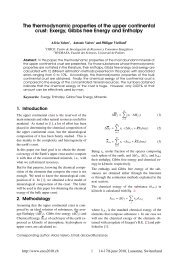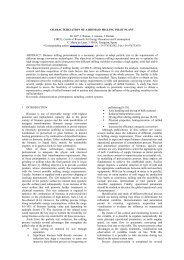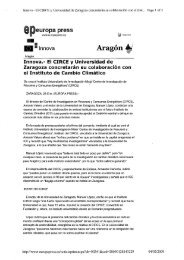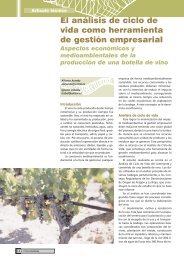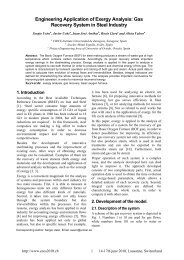APPLYING THERMOECONOMICS TO THE ANALYSIS OF ... - circe
APPLYING THERMOECONOMICS TO THE ANALYSIS OF ... - circe
APPLYING THERMOECONOMICS TO THE ANALYSIS OF ... - circe
You also want an ePaper? Increase the reach of your titles
YUMPU automatically turns print PDFs into web optimized ePapers that Google loves.
therefore a reduction of biomass resources implies a reduction of required harvest area, or what is the same, more<br />
people could be fed with the same land. Hence, the reduction of biomass requirements per habitant is also a key point in<br />
sustainable developing.<br />
4. CONCLUSIONS<br />
Symbolic thermoeconomics is a general methodology for the thermoeconomic analysis of exergy systems. Its main<br />
objective is the analysis of the cost formation process in energy systems and its interaction with the environment.<br />
The environmental impact associated to each process of the food chain system can be quantified as a cost function,<br />
in terms of natural resources consumption. This example illustrates the capabilities of thermoeconomic analysis to be<br />
applied to macroeconomic environmental systems. In this kind of systems with a high level of aggregation, it is<br />
possible to use as free variables the efficiency of the process or the structural junction ratios. However, in microsystems<br />
such as power plants with a high level of dissagregation, these parameters are mutually dependent.<br />
In the analysis made in this paper it is shown that an animal-based diet requires more energy, land and other natural<br />
resources than a plant-based diet. In fact, the production and processing of meat (and other animal products) has the<br />
largest impact on energy use, water use and land disturbance of all our various consumption activities. A soft change in<br />
the human diet, consuming less meat and supplying the required energy demand with a richer vegetal diet, provides an<br />
important fossil fuel saving and allows feeding more people. Other aspects of thermoeconomics such as the principle of<br />
non-equivalence of the irreversibilities (Kotas, 1984) are also illustrated in this example, showing the importance of<br />
reducing and recycling wastes and improving the efficiency of the last stages of the productive food chain. An<br />
improvement of the food processing can be accomplished by buying locally grown and seasonal products, reducing the<br />
fossil fuel consumption.<br />
The search of a sustainable food system will generate benefits in numerous areas: health, biodiversity, ecological<br />
restoration, energy saving or economic justice. None of these benefits alone may outweigh the apparent sort term gains<br />
of the current destructive system. But the sum of these benefits will make a more sustainable society and will help to<br />
avoid the trap of increasing production and entropy generation at the expense of a more and more degraded earth.<br />
REFERENCES<br />
Barney, G.O., 1980. “The Global 2000 Report to the President of the US. Entering the 21st Century,Vol. 1. The<br />
Summary Report” . Pergamon Press, NewYork.<br />
Cornelissen, R.L., 1997 “Thermodynamics and sustainable development; the use of exergy analysis and the reduction of<br />
irreversibility” Ph.D. Thesis, University of Twente, Enschede, The Netherlands, available at:<br />
http://doc.utwente.nl/32030<br />
Deumling, D., Wackernagel, M., and Monfreda, Ch., 2003, “Eating up the earth: how sustainable food systems shrink<br />
our ecological footprint”, Agriculture Footprint Brief, Redefining Progress, available at:<br />
http://www.rprogress.org/newpubs/2003/ag_food_0703.pdf<br />
Georgescu-Roegen N., 1971. “The Entropy Law and the Economic Process”. Harvard University Press.<br />
Kotas, T. J., 1985 “The exergy Method of Thermal Plant Analysis” Butterworths.<br />
Lozano M.A and Valero A., 1993 “Theory of exergetic cost”. Energy vol.18(9), pp. 939-960<br />
Raa, T., 2005 “The Economics of Input-Output Analysis”. Cambridge University Press.<br />
Riley, M. , 2005. “Eating green: How should we eat to best protect the environment”, available at:<br />
http://www.heia.com.au/heia_graphics/JHEIA12-1-6.pdf<br />
Torres, C., Valero, A. Serra L. And Royo, J. 2002. “Structural theory and thermoeconomic diagnosis: Part I. On<br />
malfunction and dysfunction analysis”. Energy Conversion and Management, Vol. 43, pp. 1503-1518<br />
Torres, C., 2004. “Symbolic Thermoeconomic Analysis of Energy Systems”. In Exergy, Energy System Analysis and<br />
Optimization, edited by Christos A. Frangopoulos. In Encyclopaedia of Life Support Systems (EOLSS), Developed<br />
under the Auspices of the UNESCO, Eolss Publishers, Oxford, UK. http://www.eolss.net.<br />
von Weizsacker, E. Lovins, A. and Lovins, L., 1997. Factor Four: Doubling Wealth, Halving Resource Use.- The New<br />
Report to the Club of Rome. Earthscan Ltd.<br />
Valero A., Lozano M.A., Serra L., Tsatsaronis, G., Pisa J., Frangopoulos C.A., and von Spakovsy M.R., 1994. “CGAM<br />
problem: Definition and conventional solution”. Energy vol.19. pp. 279–286.<br />
Valero A., et al., 2004. “On the thermoeconomic approach to the diagnosis of energy system malfunctions Part 1: The<br />
TADEUS problem”. Energy vol. 29, pp. 1875-1887.<br />
RESPONSIBILITY NOTICE<br />
The authors are the only responsibles for the printed material included in this paper.<br />
892



